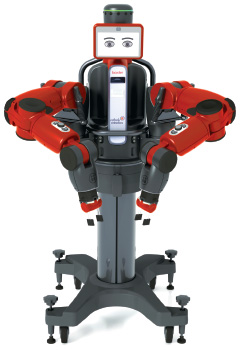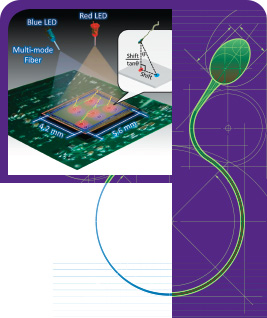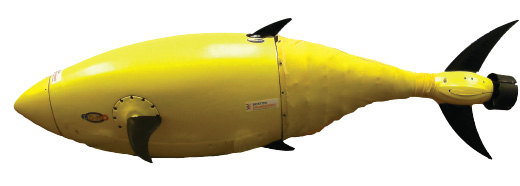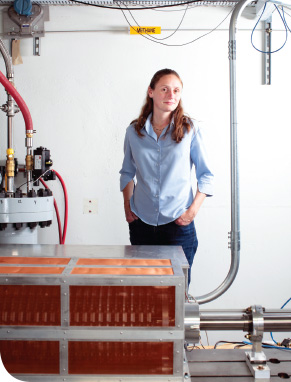November 2012 – First Look
Heavenly View
In the race for sharper digital images, the Dark Energy Camera (right) wins, hands down. The telephone-booth-size digital camera — the world’s most powerful — has 570 megapixels and took engineers, astronomers, and technicians on three continents eight years to construct. Mounted on the 4-meter Blanco telescope in Chile, it recently captured its first images from galaxies up to 8 billion light-years away. So large is the camera’s field that a single panoramic picture – like the rectangular images here – covers an area of the heavens 20 times as big as the moon, as seen from Earth. An international team’s five-year survey of the southern sky could unlock secrets of the dark matter and dark energy that make up 96 percent of the universe. And it might shed light on why the universe expands at an increasing rate. – Mary Lord
PHOTOS COURTESY OF THE DARK ENERGY SURVEY
Cheaper Help
Robots and humans don’t yet mix well in the workplace. But while research continues into ways to allow people to work more closely with their industrial mechanical brethren, Boston’s Rethink Robotics has developed an early solution. In October it began shipping the first generation of Baxter, a robot designed to do menial manufacturing and assembly tasks while in the company of humans. The $22,000 Baxter works more slowly by design than other industrial ’bots, is covered in thick, padded plastic, and crammed with sensors that allow it to recognize when it’s near a human. It then can automatically adjust its movements to avoid collision. Its relatively low price also makes it affordable for many small- to medium-size companies that previously would have found robots too costly. Baxter is trained by demonstration. Physically move its arms to show what you want it to do, press a button, and — voilà! — it’s programmed. Like the 1980s, when PCs dropped in price and became user-friendly, “it feels like a true Macintosh moment for the robot world,” former Apple designer Tony Fadell told the New York Times. Rethink, founded by former MIT robotics guru Rodney Brooks, advertises Baxter as “Astute. Aware. Affordable.” – to which we might add, “Awesome.” – Thomas K. Grose
PHOTOS COURTESY OF RETHINK ROBOTICS & BAXTER
Stealth Project
Their deliberations cloaked in secrecy, 15 judges are sifting through hundreds of nominations sent from around the world to decide which engineer – or group of up to three engineers – will receive the inaugural Queen Elizabeth Prize for Engineering. The $1.6 million prize – which aspires to be the Nobel for engineering – will reward a “groundbreaking innovation in engineering that has been of global benefit to humanity.” The winner will be named next March, and a student-designed trophy will be presented by Her Majesty in late spring. Judges include Frances Arnold, a Caltech chemical engineering professor; Stanford President John Hennessy; Calestous Juma, director of Harvard’s Science, Technology and Globalization Project; and Charles Vest, president of the National Academy of Engineering. The trophy competition, open to students ages 16 to 24, calls for a design “that represents the wonder of modern engineering.” Applicants must use 3-D online software to create their gong, and the finalists’ designs will be prototyped by a 3-D printer. – TG
Mysteries Of Sperm
Sperm are among the most important microorganisms there are. But they’ve proved hard to study because they’re as speedy as they are tiny. Aydogan Ozcan, a professor of electrical engineering at the University of California, Los Angeles, has developed a method that for the first time allows researchers to track sperm movements in 3-D. A tiny drop of liquid – one one-hundredth of a milliliter – containing 1,500 human sperm was placed on a silicon sensor chip, not unlike the kind used in smartphones. Ozcan’s team then shone a blue LED and a red LED light, set at a 45-degree angle from one another, on the sample. Each sperm cast two different shadows of different colors. The data were fed into a computer program that reconstructed the sperms’ paths, allowing researchers to see sperm movements in much greater detail than ever before. The technology might one day help improve male fertility testing. But it could also be used to study other microbes, including the one-celled organisms that contaminate drinking water, or to monitor treatments of microbial diseases. Meanwhile, scientists now know that while most sperm swim in the stereotypical squiggly paths they’ve seen before, some 4 to 5 percent swim in helices – and of those, only a mere 10 percent circle to the left instead of to the right. Why? That’s a mystery yet to be solved. – TG
PHOTOS COURTESY OF UCLA & ISTOCK
Hand Signals
Some engineers just can’t wait until they graduate to start inventing. Here’s one recent example: After watching a man with a speech impairment struggle to make a supermarket cashier understand him, three Ukrainian computer science students, who call themselves the QuadSquad, designed gloves fitted with 15 sensors that can understand the hand and finger gestures used in sign language. Via a Bluetooth connection, the decoded movements are sent to a software program that translates the data into sound, allowing a synthesizer to voice the translation and broadcast it from a smartphone’s speakers. Earlier this year, QuadSquad beat out 350 students from 75 countries to win Microsoft’s $25,000 prize, the Imagine Cup. The EnableTalk, as the device is called, runs by a battery that can be recharged by a built-in solar cell or a USB port. QuadSquad hopes to sell it for around $75. For millions of people worldwide with speech or hearing impairments, EnableTalk could be a communications bonanza. – TG
PHOTOS COURTESY OF ENABLE TALK
Channeling Lincoln
The 1862 Morrill Act provided 17.4 million acres in federal land grants that states could sell to fund the creation of agricultural and technical colleges. Sponsored by Rep. Justin Morrill of Vermont and signed by Abraham Lincoln, the law is widely seen as having transformed American higher education by opening it up to children of the working class and small farmers, women, and African-Americans. Many land-grant schools grew to become major research universities. But as their stature rose, they ceded to urban colleges the task of educating the masses. So argue four engineering deans who trekked to Capitol Hill in early fall to press lawmakers for a 21st-century equivalent of the Morrill Act – this time aimed at colleges serving the poor and underrepresented minorities. Deans Amir Mirmiran of Florida International University; Keith Moo-Young of California State University, Los Angeles; Peter Kilpatrick of Notre Dame; and Richard Schoephoerster of the University of Texas, El Paso say their initiative is aimed at training more minorities in science, technology, engineering, and math – fields the nation needs to expand. Besides a significant federal investment (including a GI Bill for STEM), key parts of the proposal include collaboration between urban schools and research universities, stronger involvement by industry, and improved K-12 preparation that integrates engineering. Just as the law signed 150 years ago helped make post-Civil War America an agricultural and industrial powerhouse, the deans contend that their plan should bring an economic payoff. – Mark Matthews
Watch Your Step
One of the biggest hazards the elderly face is the risk of falling over. In Britain, fully half of hospital admissions for those over 65 result from falls. So researchers at the University of Manchester’s Photon Science Institute have devised a smart carpet that might predict whether someone is becoming more susceptible to dangerous spills. It’s composed of plastic optical fibers laid beneath a real carpet that bend when trod upon. Each fiber has a sensor, and the information from the footfalls is sent to a computer that creates a real-time map of someone’s walking pattern. The images of footprints can be analyzed for gradual changes in gait that might determine if someone is becoming more prone to falling. Physiotherapists could also use smart carpeting to determine how well patients are responding to therapies. The smart carpet uses a tomographic technique that’s similar to scanners, and it maps a 2-D image of footsteps using light propagating beneath the carpet. Researchers say the technology could easily be retrofitted beneath existing carpets in hospital wards and nursing homes, and eventually in people’s houses. Of course, if someone does fall over, the smart carpet immediately signals an alarm. – TG
PHOTOS COURTESY OF THE UNIVERSITY OF MANCHESTER
New Life For Old Phones
As millions rushed to buy the new iPhone 5 this fall, how many considered the fate of their old phone? Americans have at least a billion electronic devices in their homes, many no longer in use. Others get tossed away, so their toxic elements end up in landfills. But for some people, used phones or tablets are all they can afford. And old parts can have value. Now, San Diego start-up ecoATM offers a cool way to stretch the life of mobile devices: a kiosk that uses machine vision, electronic analysis, and artificial intelligence to evaluate no-longer-wanted cellphones and tablets. When users place their device in the kiosk, its algorithms quickly determine what shape it’s in and what it’s worth, based on a list of ready buyers. The accuracy rate is 97.5 percent, ecoATM says. Users can trade in old devices for cash or a store credit, or they can donate the money to a charity. The kiosk spits out the money or credit slip on the spot. EcoATM says 75 percent of devices find a second home and the rest are recycled to remove toxins and rare earth elements. The first kiosks went live in 2011, and ecoATM aims for 300 kiosks in cities nationwide by year-end. A smart end for smartphones. – TG
PHOTOS COURTESY OF ECOATM
Brief & Turbulent
Mustafa Abushagur will go down in history as Libya’s first elected prime minister after more than four decades of dictatorship. He’ll most likely also have the dubious honor of having one of the shortest tenures. This former professor of microsystems engineering at Rochester Institute of Technology was elected PM by the General National Council about 11 months after the execution of former Libyan strongman Muammar Qadhafi. But on October 7, the GNC overwhelmingly voted against his proposed cabinet lineup, a move that served as a no-confidence vote. Abushagur, who received his bachelor’s degree from Tripoli University and advanced degrees in electrical engineering from Caltech, joined RIT in 2002 after a stint at the University of Alabama, Huntsville. In 2008, he was named founding president of RIT Dubai. Returning to Libya after Qadhafi’s death, he served for a year as deputy prime minister in an interim government. He became prime minister at a particularly troubled time. The day before his election, the U.S. ambassador to Libya and three other State Department employees were killed at the U.S. Consulate in Benghazi. Abushagur’s first official act was to condemn the attack. – TG
Scientists Favor Men
Research shows that subconscious gender bias can wreak havoc on the careers of women. But surely scientists, trained to focus on hard evidence, are an exception? Nope. According to a new Yale study, science professors judge women undergraduates more harshly than their male peers, even when qualifications are exactly the same. Chemistry, biology, and physics professors from six leading research universities were asked to rate the application of a student applying for a laboratory manager job. Thirty percent, or 127 professors, obliged. They all got the same application form, but half of them saw the name John on it, the other half the name Jennifer. On a scale of 1 to 7, John’s application got an average score of 4, and most professors said they would consider hiring or mentoring him. His suggested starting salary averaged $30,328. Jennifer didn’t fare as well. Her application was rated at just 3.3, fewer profs were willing to hire or mentor her, and her suggested salary averaged just $26,508. And women profs were no help to Jennifer. “Female and male faculty were equally likely to exhibit bias against the female student,” according to the study. It suggests special training of science faculty to curb subconscious bias. – TG
No Fish Story
Chalk up another technological innovation thanks to biometrics. Unmanned underwater vehicles (UUVs) have been around for years, but for some tasks, their movements are still too cumbersome. So researchers at Boston Engineering Corp., charged with building a more fishlike UUV, cast their eyes on the tuna for inspiration. Why the tuna fish? Well, thanks to eons of evolutionary development, it is one of nature’s swiftest and most nimble swimmers. The researcher’s solution is BIOSwimmer, an underwater drone with a swishy tail and fins that can glide through water. The battery-powered robotic fish is much more propulsive and maneuverable than conventional UUVs. Commissioned by the Department of Homeland Security, and loaded with sensors and an onboard computer, BIOSwimmer will not only patrol harbors but investigate the bilge and ballast tanks of tankers and also cargo ships – keeping an eye open for anything that looks fishy. – TG
PHOTOS COURTESY OF THE DEPARTMENT OF HOMELAND SECURITY
Cooler Combustion
Internal combustion engines are marvels of efficiency. But according to Shannon Miller in a recent Technology Review opinion piece, conventional engine designs are “already approaching the theoretical limits of their current architecture.” So Miller, a mechanical engineer armed with three degrees from Stanford University, two years ago cofounded EtaGen, a California start-up that’s aiming to design and build internal combustion engines unlike any that currently exist. Engines that operate at higher compression ratios are more efficient, but they also run very hot. That wastes energy and adds to the amount of friction between a piston and a cylinder. EtaGen’s reworked architecture uses a free-piston design to allow for more compression and 25 percent less fuel than conventional generators. The company initially wants to build diesel and natural-gas generators but thinks the design could work for generators in hybrid electric cars, like the Chevy Volt. This new type of engine still requires “significant development,” Miller writes, “but progress should be faster than it will be for less established new energy technologies.” If Miller’s right, her design could breathe new life into old technology. – TG
PHOTOS COURTESY OF TIMOTHY ARCHIBALD
Companies Like It
Corporate America has seen the light, according to the Solar Energy Industries Association. In a recent report, the group says the top 20 corporate solar users are generating around $47.3 million worth of electricity a year from their panels – enough juice to power more than 46,500 homes. The entire amount of corporate photovoltaic installations in the United States could power more than 390,000 homes. Led by Walmart, the list also includes Costco, Kohl’s, Ikea, Macy’s, and Walgreens. Other major names are McGraw-Hill, Johnson & Johnson, General Motors and Crayola. Apple, Bloomberg, GE, Google, Merck, and Tiffany & Co. also rely on significant amounts of solar power. What’s the appeal for corporate users? Fast-falling prices for photovoltaic arrays are lowering companies’ operating costs, the group claims. Walmart, whose solar generating capacity is 65,000 kilowatts, says it’s committed to being powered entirely from renewables and will continue to invest in solar power. “We hope to use our scale to drive down prices for all renewable energies,” the company says. Given that Walmart knows a thing or two about driving down prices, that’s good news for green power. – TG
PHOTOS COURTESY OF WALMART
Category: First Look









